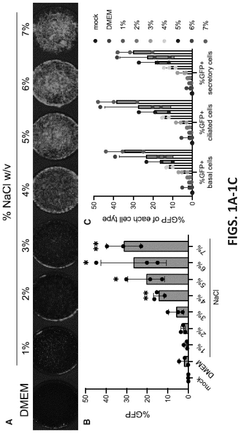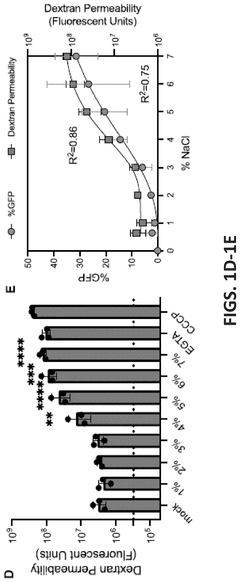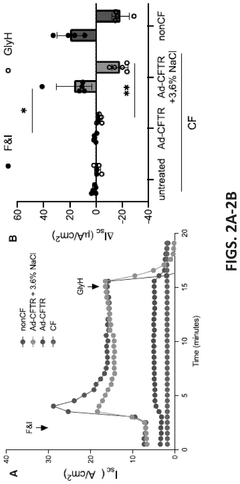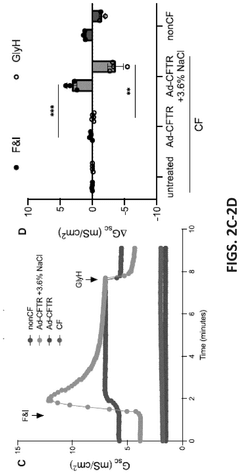How to Leverage Hypertonic Solutions in Pathogen Control?
Hypertonic Solutions in Pathogen Control: Background and Objectives
Hypertonic solutions have emerged as a promising approach in pathogen control, offering a novel and potentially effective method for managing microbial contamination across various industries. The concept of leveraging osmotic pressure to inhibit or eliminate pathogens has gained traction in recent years, driven by the increasing need for sustainable and non-toxic antimicrobial strategies.
The development of hypertonic solutions for pathogen control can be traced back to the fundamental principles of osmosis and cellular biology. Historically, high-salt environments have been used for food preservation, demonstrating the antimicrobial properties of hypertonic conditions. However, the deliberate application of this principle in modern pathogen control strategies represents a significant evolution in the field.
The primary objective of utilizing hypertonic solutions in pathogen control is to create an environment that is inhospitable to microorganisms while remaining safe for human use and environmentally friendly. This approach aims to overcome the limitations of traditional chemical disinfectants, which often pose risks to human health and contribute to the development of antimicrobial resistance.
Recent technological advancements have enabled the formulation of more sophisticated hypertonic solutions, incorporating not only salts but also other osmotically active compounds. These innovations have expanded the potential applications of hypertonic solutions beyond food preservation to areas such as medical device sterilization, water treatment, and surface disinfection in healthcare settings.
The growing interest in hypertonic solutions for pathogen control is driven by several factors. First, there is an increasing demand for alternatives to conventional antimicrobial agents due to concerns about environmental impact and the rise of antibiotic-resistant pathogens. Second, regulatory pressures are pushing industries to adopt safer and more sustainable disinfection methods. Lastly, the COVID-19 pandemic has heightened awareness of the importance of effective pathogen control measures in various settings.
As research in this field progresses, the focus is shifting towards optimizing the composition and application methods of hypertonic solutions to maximize their efficacy against a broad spectrum of pathogens. Scientists are exploring the potential synergistic effects of combining hypertonic solutions with other antimicrobial strategies, as well as investigating the mechanisms by which different pathogens respond to osmotic stress.
The development trajectory of hypertonic solutions in pathogen control points towards a future where these methods could play a significant role in public health and industrial hygiene. As such, understanding the background and objectives of this technology is crucial for guiding future research and development efforts, as well as for informing policy decisions and industry practices in pathogen control.
Market Analysis for Hypertonic Pathogen Control Methods
The market for hypertonic pathogen control methods is experiencing significant growth, driven by increasing concerns over food safety, healthcare-associated infections, and the need for effective disinfection solutions in various industries. The global market for these solutions is expected to expand rapidly in the coming years, with a particular focus on applications in food processing, healthcare facilities, and water treatment.
In the food industry, hypertonic solutions are gaining traction as an alternative to traditional chemical disinfectants. This shift is primarily due to consumer demand for cleaner labels and more natural preservation methods. The market for hypertonic solutions in food safety is particularly strong in developed regions such as North America and Europe, where stringent regulations and consumer awareness drive adoption.
The healthcare sector represents another significant market for hypertonic pathogen control methods. With the rising incidence of hospital-acquired infections and the growing threat of antibiotic-resistant pathogens, healthcare facilities are increasingly turning to innovative disinfection technologies. Hypertonic solutions offer a promising approach, especially in surface disinfection and medical device sterilization.
Water treatment is emerging as a key application area for hypertonic pathogen control. As water scarcity becomes a global concern, there is a growing need for efficient and environmentally friendly water purification methods. Hypertonic solutions show potential in this sector, particularly for treating industrial wastewater and improving the safety of drinking water in developing regions.
The market landscape is characterized by a mix of established players and innovative startups. Large multinational corporations in the chemical and healthcare industries are investing in research and development of hypertonic solutions, while specialized biotechnology firms are introducing novel formulations and application methods.
Geographically, North America and Europe currently lead the market for hypertonic pathogen control methods, owing to their advanced healthcare systems and stringent food safety regulations. However, the Asia-Pacific region is expected to witness the fastest growth, driven by rapid industrialization, increasing healthcare expenditure, and growing awareness of food safety issues.
Despite the promising outlook, the market faces challenges such as the need for extensive regulatory approvals and the initial reluctance of some industries to adopt new disinfection technologies. However, the ongoing COVID-19 pandemic has heightened awareness of the importance of effective pathogen control, potentially accelerating market growth and adoption of innovative solutions like hypertonic methods.
Current Challenges in Hypertonic Pathogen Control Techniques
Despite the promising potential of hypertonic solutions in pathogen control, several significant challenges persist in their practical application and widespread adoption. One of the primary obstacles is the limited understanding of the precise mechanisms by which hypertonic solutions affect different pathogens. While the general principle of osmotic stress is well-established, the specific molecular and cellular responses of various microorganisms to hypertonic environments remain incompletely characterized.
Another challenge lies in the development of formulations that maintain efficacy across a broad spectrum of pathogens while minimizing potential harm to host tissues or beneficial microorganisms. The optimal concentration and composition of hypertonic solutions can vary significantly depending on the target pathogen and the application context, making it difficult to create universally effective solutions.
The potential for microbial adaptation and resistance to hypertonic stress poses a significant concern. Some pathogens may develop mechanisms to counteract osmotic pressure or adapt to high-solute environments over time, potentially reducing the long-term effectiveness of hypertonic treatments. This necessitates ongoing research into resistance mechanisms and the development of strategies to mitigate adaptation.
Practical implementation of hypertonic solutions in various settings presents additional challenges. In medical applications, ensuring consistent and controlled delivery of hypertonic solutions to infected areas can be problematic, particularly in complex anatomical sites or in the presence of biofilms. In food preservation and agricultural applications, maintaining the stability and efficacy of hypertonic treatments under varying environmental conditions remains a hurdle.
The potential for unintended consequences on the broader microbial ecosystem is another area of concern. Hypertonic treatments may disrupt beneficial microbial communities or alter the balance of microorganisms in treated environments, potentially leading to unforeseen ecological or health impacts. This necessitates careful consideration of the broader ecological context in which hypertonic solutions are applied.
Regulatory and safety considerations also present challenges in the widespread adoption of hypertonic pathogen control techniques. Establishing safety profiles and obtaining regulatory approvals for novel hypertonic formulations can be time-consuming and costly, particularly for medical applications. Additionally, ensuring the safe handling and application of highly concentrated solutions in various settings requires the development of appropriate protocols and training programs.
Lastly, the cost-effectiveness and scalability of hypertonic solutions compared to existing pathogen control methods remain areas of uncertainty. While potentially effective, the production, storage, and application of hypertonic solutions may involve higher costs or logistical challenges compared to conventional antimicrobial approaches, potentially limiting their adoption in resource-constrained settings or large-scale applications.
Existing Hypertonic Pathogen Control Methodologies
01 Medical applications of hypertonic solutions
Hypertonic solutions are used in various medical applications, including treatment of edema, intracranial pressure reduction, and as a component in wound healing therapies. These solutions can help draw excess fluid from tissues and promote osmotic balance in the body.- Medical applications of hypertonic solutions: Hypertonic solutions are used in various medical applications, including treatment of edema, intracranial pressure reduction, and as a component in wound healing therapies. These solutions can help draw excess fluid from tissues and promote osmotic balance in the body.
- Formulation of hypertonic solutions for specific treatments: Hypertonic solutions are formulated with specific concentrations and compositions for targeted treatments. These may include saline solutions, sugar-based solutions, or combinations of electrolytes designed to address particular medical conditions or physiological imbalances.
- Use of hypertonic solutions in cell culture and preservation: Hypertonic solutions play a crucial role in cell culture techniques and preservation of biological materials. They are used to maintain osmotic balance, control cell volume, and protect cells during cryopreservation processes.
- Hypertonic solutions in diagnostic procedures: Hypertonic solutions are employed in various diagnostic procedures, such as contrast-enhanced imaging studies and tests for assessing gastrointestinal function. These solutions can enhance visibility of specific structures or help evaluate physiological responses.
- Development of novel hypertonic solution delivery systems: Innovative delivery systems for hypertonic solutions are being developed to improve their efficacy and ease of administration. These may include specialized devices, controlled release formulations, or combination therapies that enhance the overall therapeutic effect of hypertonic solutions.
02 Formulation of hypertonic solutions for specific treatments
Hypertonic solutions are formulated with specific concentrations and compositions for targeted treatments. These may include saline solutions, sugar-based solutions, or combinations of electrolytes designed to address particular medical conditions or physiological imbalances.Expand Specific Solutions03 Use of hypertonic solutions in cell culture and preservation
Hypertonic solutions play a crucial role in cell culture techniques and preservation of biological samples. They are used to maintain osmotic balance, prevent cell lysis, and optimize conditions for cell growth and storage.Expand Specific Solutions04 Hypertonic solutions in diagnostic and analytical applications
Hypertonic solutions are utilized in various diagnostic and analytical procedures, including sample preparation, separation techniques, and as reagents in biochemical assays. They can help concentrate analytes and improve detection sensitivity in laboratory tests.Expand Specific Solutions05 Development of novel hypertonic solution delivery systems
Research is ongoing to develop innovative delivery systems for hypertonic solutions, including controlled-release formulations, targeted delivery mechanisms, and combination therapies. These advancements aim to improve the efficacy and safety of hypertonic solution treatments.Expand Specific Solutions
Key Players in Hypertonic Pathogen Control Industry
The leveraging of hypertonic solutions in pathogen control is an emerging field in the early stages of development. The market size is growing as industries seek innovative approaches to combat pathogens. While the technology is still evolving, several key players are advancing its maturity. Companies like Endocyte, Inc. and BASF Plant Science LLC are exploring applications in agriculture and plant protection. Universities such as Purdue Research Foundation and University of California San Diego are conducting foundational research. Biotech firms like Ginkgo Bioworks, Inc. and Aphios Corp. are developing novel applications. The involvement of diverse entities, from academic institutions to industry leaders, indicates a competitive landscape with significant potential for growth and innovation in pathogen control using hypertonic solutions.
Agri Neo, Inc.
Aphios Corp.
Innovative Approaches in Hypertonic Solution Application
- The use of a hypertonic solution, specifically a hypertonic salt solution with a salt concentration ranging from about 1% to 8%, is introduced to enhance the delivery of gene therapy vectors by contacting cells with it before, after, or simultaneously with the vectors, thereby improving gene transfer efficiency.
- A medicinal composition comprising hypertonic sodium chloride, a vasodilator, and a phosphate source, which reduces hemoglobin's intrinsic affinity for oxygen, increases oxygen transport, and enhances tissue oxygen extraction capacity, while maintaining acidosis to improve oxygen delivery to tissues.
Environmental Impact of Hypertonic Pathogen Control Methods
The environmental impact of hypertonic pathogen control methods is a critical consideration in their implementation and long-term sustainability. These methods, which leverage high-concentration solutions to inhibit or eliminate pathogens, can have both positive and negative effects on the surrounding ecosystem.
One of the primary environmental benefits of hypertonic solutions in pathogen control is the reduced reliance on traditional chemical pesticides and antimicrobials. By utilizing naturally occurring substances or safe, biodegradable compounds, these methods can significantly decrease the introduction of harmful chemicals into soil, water systems, and food chains. This reduction in chemical usage can lead to improved soil health, preservation of beneficial microorganisms, and decreased risk of contamination in nearby water bodies.
However, the widespread application of hypertonic solutions may also pose certain environmental challenges. The high salt concentrations used in these methods can potentially alter soil salinity levels, especially in agricultural settings. Increased soil salinity can negatively impact plant growth, reduce crop yields, and affect soil structure. In aquatic environments, the discharge of hypertonic solutions may disrupt local osmotic balances, potentially harming sensitive aquatic organisms and altering ecosystem dynamics.
The production and distribution of hypertonic solutions for pathogen control also carry environmental implications. The manufacturing process may require significant energy inputs and raw materials, contributing to carbon emissions and resource depletion. Additionally, the transportation and storage of these solutions can have associated environmental costs, including fuel consumption and potential risks of spills or leaks.
To mitigate these environmental concerns, researchers and industry professionals are exploring more sustainable approaches to hypertonic pathogen control. These include the development of biodegradable hypertonic compounds, precision application techniques to minimize environmental exposure, and closed-loop systems for solution recycling and reuse. Furthermore, efforts are being made to optimize the concentration and composition of hypertonic solutions to achieve effective pathogen control while minimizing environmental impact.
The long-term ecological effects of hypertonic pathogen control methods are still being studied. Ongoing research focuses on assessing the impact on soil microbial communities, potential for pathogen resistance development, and effects on non-target organisms. Understanding these complex interactions is crucial for developing environmentally responsible and sustainable pathogen control strategies.
In conclusion, while hypertonic solutions offer promising alternatives to conventional pathogen control methods, their environmental impact must be carefully managed. Balancing the benefits of effective pathogen control with the need for environmental preservation requires ongoing research, innovation, and responsible implementation practices.
Safety Regulations for Hypertonic Solutions in Pathogen Control
The implementation of hypertonic solutions in pathogen control necessitates strict adherence to safety regulations to ensure the protection of human health and the environment. These regulations encompass various aspects of production, handling, application, and disposal of hypertonic solutions used in pathogen control processes.
Regulatory bodies, such as the Environmental Protection Agency (EPA) and the Food and Drug Administration (FDA) in the United States, play crucial roles in establishing and enforcing safety standards for hypertonic solutions. These agencies provide guidelines on the appropriate concentrations, application methods, and safety precautions for different types of hypertonic solutions used in pathogen control.
One of the primary safety concerns is the potential for chemical burns or irritation caused by high-concentration hypertonic solutions. Regulations typically mandate the use of personal protective equipment (PPE) for workers handling these solutions, including chemical-resistant gloves, goggles, and protective clothing. Additionally, safety protocols often require proper ventilation in areas where hypertonic solutions are prepared or applied to prevent inhalation of potentially harmful vapors.
Storage and transportation of hypertonic solutions are subject to specific regulations to prevent accidental spills or exposure. These may include requirements for secure containment, proper labeling, and segregation from incompatible substances. Emergency response procedures and spill containment protocols are also typically mandated to mitigate potential environmental impacts in case of accidents.
The application of hypertonic solutions in food processing and agricultural settings is subject to particularly stringent regulations. These often include limitations on residual levels of hypertonic agents in food products, as well as guidelines for proper rinsing and post-treatment handling to ensure food safety.
Environmental considerations are also addressed in safety regulations for hypertonic solutions. Disposal methods must comply with local and national environmental protection laws to prevent contamination of water sources or soil. This may involve neutralization processes or specialized waste treatment facilities for certain types of hypertonic solutions.
Regulatory frameworks often require comprehensive documentation and record-keeping for the use of hypertonic solutions in pathogen control. This includes maintaining safety data sheets (SDS), conducting regular safety audits, and providing thorough training for personnel involved in handling these solutions.
As research continues to advance in the field of hypertonic solutions for pathogen control, safety regulations are regularly reviewed and updated to address new findings and potential risks. Compliance with these evolving regulations is essential for organizations leveraging hypertonic solutions in their pathogen control strategies, ensuring both efficacy and safety in their applications.







